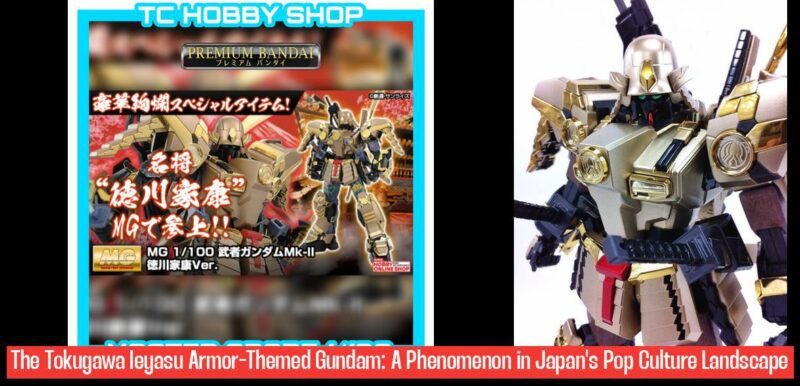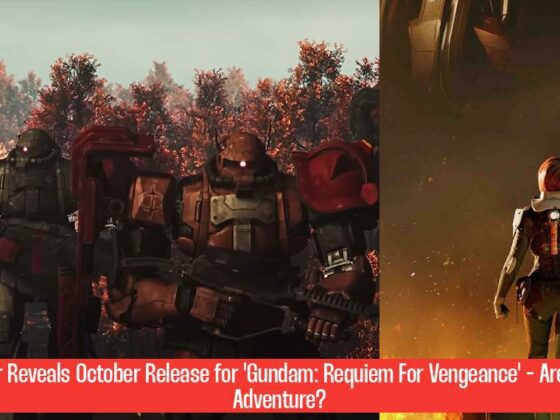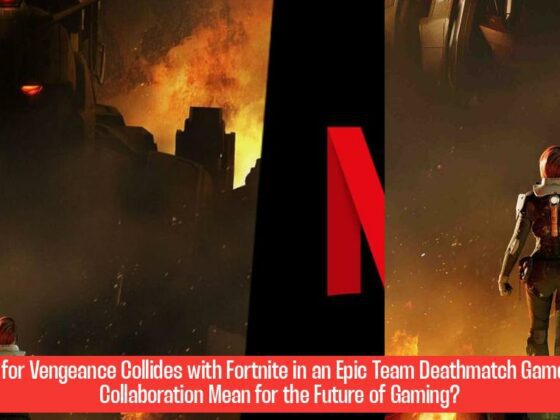Gundam Meets History: The Tokugawa Ieyasu Armor-Themed Model Takes Japan by Storm
In the world of Gundam, where giant robots clash in epic battles, a unique fusion of history and pop culture has captured the hearts of fans across Japan. The MG 1/100 Musha Gundam Mk-II Tokugawa Ieyasu Nanban-Dogusoku Ver. model, a plastic model kit featuring the iconic Gundam sporting armor inspired by the legendary Tokugawa Ieyasu, has become a runaway success, sparking a wave of excitement among collectors and history enthusiasts alike.
The model, a collaboration between Bandai Namco Holdings Inc., the powerhouse behind the Gundam franchise, and Nikko Toshogu shrine, is not just a testament to the enduring popularity of Gundam but also a celebration of Japanese history. The armor adorning the Gundam, known as “nanban-dogusoku,” is a real piece of history, designated as an important cultural property by the Japanese government and housed at Nikko Toshogu shrine. The armor is believed to have been worn by Ieyasu himself during the pivotal Battle of Sekigahara in 1600, a battle that ultimately led to the establishment of the Tokugawa Shogunate and ushered in a new era of peace and stability for Japan.
The model itself is a marvel of detail and craftsmanship, meticulously crafted to capture the essence of the nanban-dogusoku armor. The helmet, inspired by Spanish designs, adds a touch of European flair to the ensemble. The black armor, adorned with red “kusazuri” plates hanging from it, evokes the grandeur and authority of the Tokugawa era. The model’s design is a testament to the artistry and passion of the creators, showcasing the intricate details that bring history to life. But the success of the Musha Gundam Mk-II Tokugawa Ieyasu Nanban-Dogusoku Ver. goes beyond its aesthetic appeal. It represents a unique opportunity to connect with history, to explore the past through the lens of pop culture. For Gundam fans, it’s a chance to see their beloved robot in a new light, infused with the spirit of a legendary figure who shaped Japan’s destiny. For history enthusiasts, it’s a gateway to discovering the intricacies of the nanban-dogusoku armor and the fascinating era it represents. The model has sparked conversations about Japan’s rich history, encouraging people to learn more about their heritage and appreciate the legacy of figures like Tokugawa Ieyasu.
Don’t Miss – Embracing your Inner Superhero: A Vibrant Celebration of Comics at First Coast Comic Con
The initial release of the model at Nikko Toshogu shrine in late May was met with overwhelming enthusiasm. The first batch of 2,000 models sold out immediately, a testament to the model’s popularity and the enduring appeal of the Gundam franchise. The success of the model is a result of a harmonious collaboration between Bandai Namco Holdings Inc. and Nikko Toshogu shrine, a partnership that brought together the world of Gundam and the world of history. This collaboration has not only generated excitement among fans but has also served as a platform for promoting the 25th anniversary of the registration of shrines and temples of Nikko as a collective World Heritage site. The model is a powerful symbol of the enduring legacy of Tokugawa Ieyasu and the rich history he represents, and it has sparked a renewed interest in the nanban-dogusoku armor, a piece of history that had previously been overlooked. The model’s success is a testament to the power of pop culture to engage with history and inspire a renewed appreciation for the past. It is a reminder that even in a world of cutting-edge technology and futuristic robots, there is still a profound connection to the legacies of our ancestors, and the stories they leave behind.
A Fusion of History and Pop Culture: The Brainchild of a Gundam Fan
The Musha Gundam Mk-II Tokugawa Ieyasu Nanban-Dogusoku Ver. model is the brainchild of Takamasa Inaba, the second-ranking priest of Nikko Toshogu shrine. Inaba, a diehard Gundam fan, recognized an opportunity to bridge the gap between history and pop culture. His vision was to create a model that would not only celebrate the 25th anniversary of the registration of shrines and temples of Nikko as a collective World Heritage site but also bring the history of the nanban-dogusoku armor to a wider audience.
Inaba’s passion for Gundam and his deep understanding of the shrine’s history led him to approach Bandai Namco Holdings Inc. with his vision. The company, recognizing the potential of the project, readily agreed to collaborate. The result is a model that embodies the spirit of both history and pop culture, a testament to the power of collaboration and the shared passion for innovation. The model is a tribute to the legacy of Ieyasyu and the nanban-dogusoku armor, but it is also a testament to the enduring appeal of the Gundam franchise and the power of creativity to bridge the gap between different worlds. The success of the Musha Gundam Mk-II Tokugawa Ieyasu Nanban-Dogusoku Ver. model is a testament to Inaba’s vision and the power of collaboration between history and pop culture, a fusion that has captivated the imagination of collectors and history enthusiasts alike.
The nanban-dogusoku armor, a fascinating piece of history, had previously been overshadowed by other artifacts housed at the shrine. However, the Musha Gundam Mk-II Tokugawa Ieyasu Nanban-Dogusoku Ver. model has breathed new life into this historical treasure, sparking a renewed interest in its story. The model has served as a catalyst for people to learn more about the nanban-dogusoku armor and the era it represents, highlighting the significance of these historical artifacts and the stories they hold. The model’s success is a testament to the power of pop culture to engage with history and bring it to life for a new generation, inspiring a renewed appreciation for the past and the legacies it holds.
The Legacy of Tokugawa Ieyasu and the Nanban-Dogusoku Armor
Tokugawa Ieyasu, the founder of the Tokugawa Shogunate, is a revered figure in Japanese history. His leadership paved the way for a period of peace and stability that lasted over 250 years, known as the Edo period. The nanban-dogusoku armor, believed to have been worn by Ieyasu during the Battle of Sekigahara, is a tangible reminder of his power and influence. It is a symbol of the era of the samurai, a time when warriors were renowned for their skill and valor. The armor, with its European influences, reflects the cultural exchange that took place between Japan and the West during the 16th and 17th centuries. It is a testament to the adaptability and openness of Japanese society, a society that embraced foreign influences while maintaining its own unique cultural identity. The nanban-dogusoku armor is not just a piece of history; it is a window into a bygone era, a time when Japan was on the cusp of a new chapter in its history.
The Musha Gundam Mk-II Tokugawa Ieyasu Nanban-Dogusoku Ver. model has brought this historical treasure to the forefront, sparking a renewed interest in its significance and the era it represents. The model has served as a catalyst for people to learn more about the nanban-dogusoku armor, its origins, and the legacy of Tokugawa Ieyasu. The model’s success is a testament to the power of pop culture to engage with history and bring it to life for a new generation, inspiring a renewed appreciation for the past and the legacies it holds. It is a reminder that even in a world of rapid technological advancements, there is still a profound connection to the stories of our ancestors, and the lessons they offer.
Beyond the Model: A Legacy of Collaboration and Innovation
The Musha Gundam Mk-II Tokugawa Ieyasu Nanban-Dogusoku Ver. model is more than just a plastic model; it is a symbol of collaboration, innovation, and the enduring power of pop culture. The success of the model is a testament to the partnership between Bandai Namco Holdings Inc. and Nikko Toshogu shrine, a partnership that brought together the world of Gundam and the world of history. This collaboration has not only generated excitement among fans but has also served as a platform for promoting the 25th anniversary of the registration of shrines and temples of Nikko as a collective World Heritage site.
The model’s success is a reminder of the power of creativity to bridge the gap between different worlds, to inspire new ways of understanding and appreciating our history. The Musha Gundam Mk-II Tokugawa Ieyasu Nanban-Dogusoku Ver. model is a testament to the enduring appeal of the Gundam franchise and the power of collaboration to bring together different communities and interests. It is a model that embodies the spirit of innovation, a spirit that continues to drive the Gundam franchise and the world of pop culture.
More related > Is the Global Food Supply in Danger? Researchers Uncover Troubling Trend in Plant Pollination Patterns
What is the MG 1/100 Musha Gundam Mk-II Tokugawa Ieyasu Nanban-Dogusoku Ver. model?
The MG 1/100 Musha Gundam Mk-II Tokugawa Ieyasu Nanban-Dogusoku Ver. model is a plastic model kit featuring the iconic Gundam robot adorned with armor inspired by the legendary Tokugawa Ieyasu.
What is the significance of the nanban-dogusoku armor featured on the Gundam model?
The nanban-dogusoku armor is a real piece of history designated as an important cultural property by the Japanese government and believed to have been worn by Tokugawa Ieyasu himself during the Battle of Sekigahara in 1600.
Who collaborated to create the Musha Gundam Mk-II Tokugawa Ieyasu Nanban-Dogusoku Ver. model?
The model is a collaboration between Bandai Namco Holdings Inc., the company behind the Gundam franchise, and Nikko Toshogu shrine, where the original nanban-dogusoku armor is housed.
What impact has the Musha Gundam Mk-II Tokugawa Ieyasu Nanban-Dogusoku Ver. model had on fans and history enthusiasts?
The model has sparked excitement among collectors and history enthusiasts, providing a unique opportunity to connect with Japanese history through the lens of pop culture, encouraging conversations about Japan’s rich heritage and the legacy of figures like Tokugawa Ieyasu.



